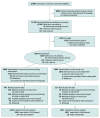Effect of an Intensive Nurse Home Visiting Program on Adverse Birth Outcomes in a Medicaid-Eligible Population: A Randomized Clinical Trial
- PMID: 35788794
- PMCID: PMC9257581
- DOI: 10.1001/jama.2022.9703
Effect of an Intensive Nurse Home Visiting Program on Adverse Birth Outcomes in a Medicaid-Eligible Population: A Randomized Clinical Trial
Erratum in
-
Incorrect Data in Table.JAMA. 2023 Feb 28;329(8):687. doi: 10.1001/jama.2023.0262. JAMA. 2023. PMID: 36853261 Free PMC article. No abstract available.
Abstract
Importance: Improving birth outcomes for low-income mothers is a public health priority. Intensive nurse home visiting has been proposed as an intervention to improve these outcomes.
Objective: To determine the effect of an intensive nurse home visiting program on a composite outcome of preterm birth, low birth weight, small for gestational age, or perinatal mortality.
Design, setting, and participants: This was a randomized clinical trial that included 5670 Medicaid-eligible, nulliparous pregnant individuals at less than 28 weeks' gestation, enrolled between April 1, 2016, and March 17, 2020, with follow-up through February 2021.
Interventions: Participants were randomized 2:1 to Nurse Family Partnership program (n = 3806) or control (n = 1864). The program is an established model of nurse home visiting; regular visits begin prenatally and continue through 2 postnatal years. Nurses provide education, assessments, and goal-setting related to prenatal health, child health and development, and maternal life course. The control group received usual care services and a list of community resources. Neither staff nor participants were blinded to intervention group.
Main outcomes and measures: There were 3 primary outcomes. This article reports on a composite of adverse birth outcomes: preterm birth, low birth weight, small for gestational age, or perinatal mortality based on vital records, Medicaid claims, and hospital discharge records through February 2021. The other primary outcomes of interbirth intervals of less than 21 months and major injury or concern for abuse or neglect in the child's first 24 months have not yet completed measurement. There were 54 secondary outcomes; those related to maternal and newborn health that have completed measurement included all elements of the composite plus birth weight, gestational length, large for gestational age, extremely preterm, very low birth weight, overnight neonatal intensive care unit admission, severe maternal morbidity, and cesarean delivery.
Results: Among 5670 participants enrolled, 4966 (3319 intervention; 1647 control) were analyzed for the primary maternal and neonatal health outcome (median age, 21 years [1.2% non-Hispanic Asian, Indigenous, or Native Hawaiian and Pacific Islander; 5.7% Hispanic; 55.2% non-Hispanic Black; 34.8% non-Hispanic White; and 3.0% more than 1 race reported [non-Hispanic]). The incidence of the composite adverse birth outcome was 26.9% in the intervention group and 26.1% in the control group (adjusted between-group difference, 0.5% [95% CI, -2.1% to 3.1%]). Outcomes for the intervention group were not significantly better for any of the maternal and newborn health primary or secondary outcomes in the overall sample or in either of the prespecified subgroups.
Conclusions and relevance: In this South Carolina-based trial of Medicaid-eligible pregnant individuals, assignment to participate in an intensive nurse home visiting program did not significantly reduce the incidence of a composite of adverse birth outcomes. Evaluation of the overall effectiveness of this program is incomplete, pending assessment of early childhood and birth spacing outcomes.
Trial registration: ClinicalTrials.gov Identifier: NCT03360539.
Conflict of interest statement
Figures


Comment in
-
Intensive Nurse Home Visiting Program and Adverse Birth Outcomes.JAMA. 2022 Jul 5;328(1):23-24. doi: 10.1001/jama.2022.9162. JAMA. 2022. PMID: 35788814 No abstract available.
References
-
- Sacchi C, Marino C, Nosarti C, Vieno A, Visentin S, Simonelli A. Association of intrauterine growth restriction and small for gestational age status with childhood cognitive outcomes: a systematic review and meta-analysis. JAMA Pediatr. 2020;174(8):772-781. doi:10.1001/jamapediatrics.2020.1097 - DOI - PMC - PubMed
-
- Behrman RE, Butler AS, eds; Institute of Medicine (US) Committee on Understanding Premature Birth and Assuring Healthy Outcomes . Preterm Birth: Causes, Consequences, and Prevention. National Academies Press; 2007. http://www.ncbi.nlm.nih.gov/books/NBK11362/ - PubMed
Publication types
MeSH terms
Associated data
LinkOut - more resources
Full Text Sources
Medical
Miscellaneous

